An Adaptable Conceptual Model for Construction Technology Transfer: The BRI in Africa, the Case of Ethiopia
Abstract
:1. Introduction
2. The Current State of TT and the BRI in Africa
2.1. The BRI and Technology Transfer
2.2. The Existing Technology Transfer Models
2.2.1. The Bar-Zakay Model
2.2.2. The Dahlman and Westphal Model
2.2.3. The Schlie, Radnor, and Wad Model
2.3. The Experience of China in TT and Innovation
2.4. The Current Problem
3. Methods
4. The Proposed Model
4.1. The Model
4.2. Mathematical Representation of the Loop Diagram
- X = Systematic TT,
- Y = Domestic technology capacity, and
- Z = Forced joint-venture.


4.3. Structural Validation of the Causal Loop Diagram
5. Case Studies
5.1. Case 1: The Addis Ababa 40/60 Housing BIM Adoption Project
5.1.1. Project Description
5.1.2. The TT Transfer Process
5.2. Case 2: The Skyscraper Project
5.2.1. Project Description
5.2.2. The Construction Technologies and the Transfer Process
5.3. Case 3: The Railway Project
5.3.1. Project Description
5.3.2. The Railway Technologies and Transfer Process
6. Discussion and Conclusions
Author Contributions
Funding
Institutional Review Board Statement
Informed Consent Statement
Data Availability Statement
Conflicts of Interest
Abbreviations
| AEC | Architecture, Engineering, and Construction |
| BIM | Building Information Modelling |
| BRI | Belt & Road Initiative |
| CTT | Construction Technology Transfer |
| FDI | Foreign Direct Investment |
| MOU | Memorandum of Understanding |
| R&D | Research and Development |
| TT | Technology Transfer |
| UIL | University-Industry Linkage |
References
- Herrero, A.G.; Xu, J. China’s belt and road initiative: Can Europe expect trade gains? China World Econ. 2017, 25, 84–99. [Google Scholar] [CrossRef] [Green Version]
- Breuer, J. Two belts, one road?—The role of Africa in Chinas’s belt & road initiative. CrossAsia-Respiratory 2017. [Google Scholar] [CrossRef]
- Zhang, Y.-J.; Jin, Y.-L.; Shen, B. Measuring the energy saving and CO2 emissions reduction potential under China’s belt and road initiative. Comput. Econ. 2020, 55, 1095–1116. [Google Scholar] [CrossRef]
- Ehizuelen, M.M.O. More African countries on the route: The positive and negative impacts of the Belt and Road Initiative. Transnatl. Corp. Rev. 2017, 9, 341–359. [Google Scholar] [CrossRef]
- Ehizuelen, M.M.O.; Abdi, H.O. Sustaining China-Africa relations: Slotting Africa into China’s one belt, one road initiative makes economic sense. Asian J. Comp. Polit. 2018, 3, 285–310. [Google Scholar] [CrossRef]
- Sun, J.; Zhu, L.; Wu, J. The development status of construction equipment and technology in China. MSE 2018, 399, 012048. [Google Scholar] [CrossRef] [Green Version]
- Dodge Data Analytics. The Business Value of BIM in China; SmartMarket Report; Dodge Data Analitics: Bedford, MA, USA, 2015. [Google Scholar]
- Li, A. Technology transfer in China-Africa relation: Myth or reality. Transnatl. Corp. Rev. 2016, 8, 183–195. [Google Scholar] [CrossRef]
- Battistella, C.; De Toni, A.F.; Pillon, R. Inter-organisational technology/knowledge transfer: A framework from critical literature review. J. Technol. Transf. 2016, 41, 1195–1234. [Google Scholar] [CrossRef]
- Grosse, R. Technology transfer in services. J. Int. Bus. Stud. 1996, 27, 781–800. [Google Scholar] [CrossRef]
- Good, M.; Knockaert, M.; Soppe, B.; Wright, M. The technology transfer ecosystem in academia. An organizational design perspective. Technovation 2019, 82, 35–50. [Google Scholar] [CrossRef]
- Hoffman, K.; Girvan, N. Managing international technology transfer: A strategic approach for developing countries. Manuscr. Rep. IDRC 259e. 1990. Available online: https://scholar.google.com/scholar?hl=en&as_sdt=0%2C5&q=hoffman+managing+international+technology+transfer&btnG= (accessed on 7 January 2021).
- Siegel, D.S.; Wright, M. University technology transfer offices, licensing, and start-ups. In Chicago Handbook of University Technology Transfer and Academic Entrepreneurship; University of Chicago: Chicago, IL, USA, 2015; Volume 1, pp. 84–103. [Google Scholar]
- Hassink, R. Technology transfer infrastructures: Some lessons from experiences in Europe, the US and Japan. Eur. Plan. Stud. 1997, 5, 351–370. [Google Scholar] [CrossRef]
- Wong, P.K.; Singh, A. From technology adopter to innovator: Singapore. In Small Country Innovation Systems: Globalization, Change and Policy in Asia and Europe; Edward Elgar Publishing: Northampton, MA, USA, 2008; pp. 71–112. [Google Scholar]
- Li, X. Sources of external technology, absorptive capacity, and innovation capability in Chinese state-owned high-tech enterprises. World Dev. 2011, 39, 1240–1248. [Google Scholar] [CrossRef]
- Andreosso-O’Callaghan, B. Technology transfer: A mode of collaboration between the European Union and China. Eur. Asia Stud. 1999, 51, 123–142. [Google Scholar] [CrossRef]
- Feinstein, C.; Howe, C. Chinese Technology Transfer in the 1990s; Edward Elgar Publishing: Lypiatt, UK; Cheltenham, UK, 1997. [Google Scholar]
- Xu, F. Strategic tension for China high-speed railway to go global. In The Belt and Road; Springer: Berlin, Germany, 2018; pp. 75–114. [Google Scholar]
- Carey, R.; Xiaoyun, L. China’s Comprehensive Strategic and Cooperative Partnership with Africa; IDS policy Briefing 111; IDS: Brighton, UK, 2016. [Google Scholar]
- Demissie, A.; Weigel, M.; Xiaoyang, T. China’s Belt and Road Initiative and Its Implications for Africa; World Wide Fund (WWF): Nairobi, Kenya, 2016. [Google Scholar]
- Demissie, A. Special economic zones: Integrating African countries in China’s Belt and Road initiative. In Rethinking the Silk Road; Springer: Berlin, Germany, 2018; pp. 69–84. [Google Scholar]
- Oqubay, A. Made in Africa: Industrial Policy in Ethiopia; Oxford University Press: Oxford, UK, 2015. [Google Scholar]
- Bräutigam, D.; Tang, X. Going global in groups: Structural transformation and China’s special economic zones overseas. World Dev. 2014, 63, 78–91. [Google Scholar] [CrossRef]
- Adzroe, E.K. A Study of e-Business Technology Transfer via Foreign Direct Investment in the Ghanaian Construction Industry; University of Salford: Salford, UK, 2015. [Google Scholar]
- Frank, I.U.; Du, R. Factors influencing technology transfer for sustainable construction management in Nigeria. Engineering 2018, 10, 769. [Google Scholar] [CrossRef] [Green Version]
- Abbott, F.M.; Correa, C.M.; Drahos, P. Emerging Markets and the World Patent Order; Edward Elgar Publishing: Lypiatt, UK; Cheltenham, UK, 2013. [Google Scholar]
- Ramanathan, K.; Jacobs, K.; Bnadyopadhyay, M. An overview of technology transfer and technology transfer models. In Overview of Technology Transfer and Small & Medium Enterprises in Developing Countries; Daya Publishing House: Delhi, India, 2011. [Google Scholar]
- Bar-Zakay, S.N. Technology Transfer Model; Rand Corp Santa Monica Calif: Santa Monica, CA, USA, 1970. [Google Scholar]
- Bozeman, B. Technology transfer and public policy: A review of research and theory. Res. Policy 2000, 29, 627–655. [Google Scholar] [CrossRef]
- Jagoda, K. A Stage-Gate Model for Planning and Implementing International Technology Transfer. Ph.D. Thesis, University of Western Sydney, Sydney, Australia, 2007. [Google Scholar]
- Lee, J.; Bae, Z.T.; Choi, D.K. Technology development processes: A model for a developing country with a global perspective. RD Manag. 1988, 18, 235–250. [Google Scholar] [CrossRef]
- Bell, M.; Ross-Larson, B.; Westphal, L.E. Assessing the performance of infant industries. J. Dev. Econ. 1984, 16, 101–128. [Google Scholar] [CrossRef]
- Khabiri, N.; Rast, S.; Senin, A.A. Identifying main influential elements in technology transfer process: A conceptual model. Procedia Soc. Behav. Sci. 2012, 40, 417–423. [Google Scholar] [CrossRef] [Green Version]
- Xu, S.; Zhu, K.; Gibbs, J. Global technology, local adoption: A cross-country investigation of internet adoption by companies in the united states and china. Electron. Mark. 2004, 14, 13–24. [Google Scholar] [CrossRef]
- Liu, H.; Jiang, Y. Technology transfer from higher education institutions to industry in China: Nature and implications. Technovation 2001, 21, 175–188. [Google Scholar] [CrossRef]
- Miesing, P.; Kriger, M.P.; Slough, N. Towards a model of effective knowledge transfer within transnationals: The case of Chinese foreign invested enterprises. J. Technol. Transf. 2007, 32, 109–122. [Google Scholar] [CrossRef] [Green Version]
- Sterman, J.D. System dynamics modeling: Tools for learning in a complex world. Calif. Manag. Rev. 2001, 43, 8–25. [Google Scholar] [CrossRef]
- Haraldsson, H.V. Introduction to System Thinking and Causal Loop Diagrams; Department of Chemical Engineering, Lund University: Lund, Sweden, 2004. [Google Scholar]
- Tip, T. Guidelines for drawing causal loop diagrams. Syst. Think. 2011, 22. Available online: https://thesystemsthinker.com/wp-content/uploads/pdfs/220109pk.pdf (accessed on 7 January 2021).
- Haraldsson, H.V. Introduction to systems and causal loop diagrams. In System Dynamic Course; Lumes Lund University: Lund, Sweden, 2000. [Google Scholar]
- Burns, J.R.; Musa, P. Structural validation of causal loop diagrams. In Proceedings of the Atlanta SD Conference, Atlanta, GE, USA, 23–27 July 2001. [Google Scholar]
- Goldratt, E.M. Theory of Constraints; North River Croton-on-Hudson: New York, NY, USA, 1990. [Google Scholar]
- Mattila, M. Job load and hazard analysis: A method for the analysis of workplace conditions for occupational health care. Occup. Environ. Med. 1985, 42, 656–666. [Google Scholar] [CrossRef] [Green Version]
- Rozenfeld, O.; Sacks, R.; Rosenfeld, Y.; Baum, H. Construction job safety analysis. Saf. Sci. 2010, 48, 491–498. [Google Scholar] [CrossRef]
- Groeger, J.A. How many e’s in road safety? In Handbook of Traffic Psychology; Elsevier: Amesterdam, The Netherlands, 2011; pp. 3–12. [Google Scholar]
- Zhang, S. Study on technology system and system integration method of China high-speed railway. In Proceedings of the 2010 Joint Rail Conference, Urbana, IL, USA, 27–29 April 2010; pp. 501–506. [Google Scholar]
- Styan, D. Djibouti: Changing Influence in the Horn’s Strategic Hub; The Royal Institute of International Affairs: London, UK, 2013. [Google Scholar]
- Tarrosy, I.; Zoltán, V. China and Ethiopia, Part 2: The Addis Ababa-Djibuti Railway. The Diplomat. 22 February 2018. Available online: https://thediplomat.com/2018/02/china-and-ethiopia-part-2-the-addis-ababa-djibouti-railway/ (accessed on 7 January 2021).
- Ali, G.S. Post completion sustainability of Ethiopian railway project: The case of Addis Ababa light rail transit project (AALRTP). Management 2017, 7, 7–28. [Google Scholar]
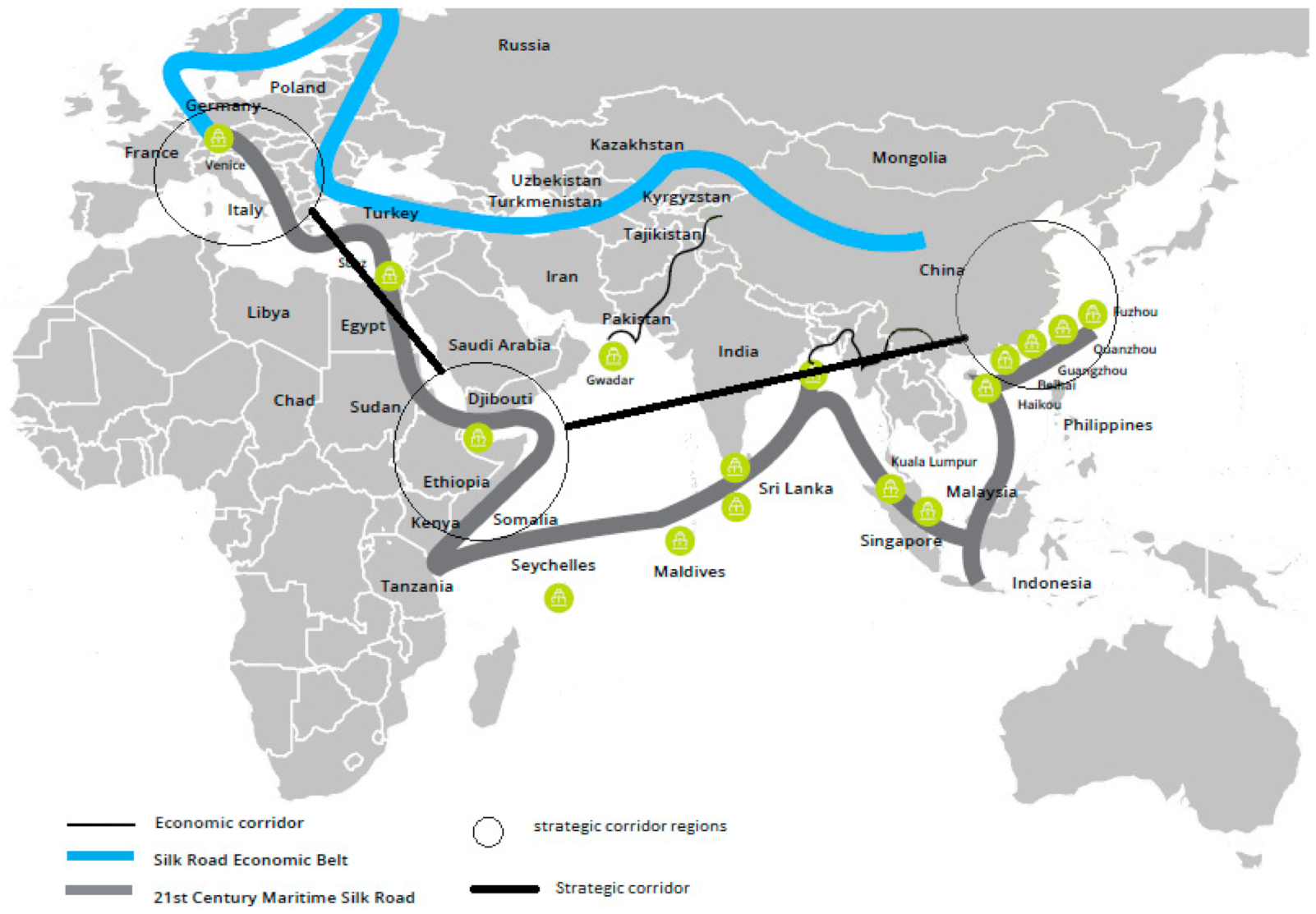

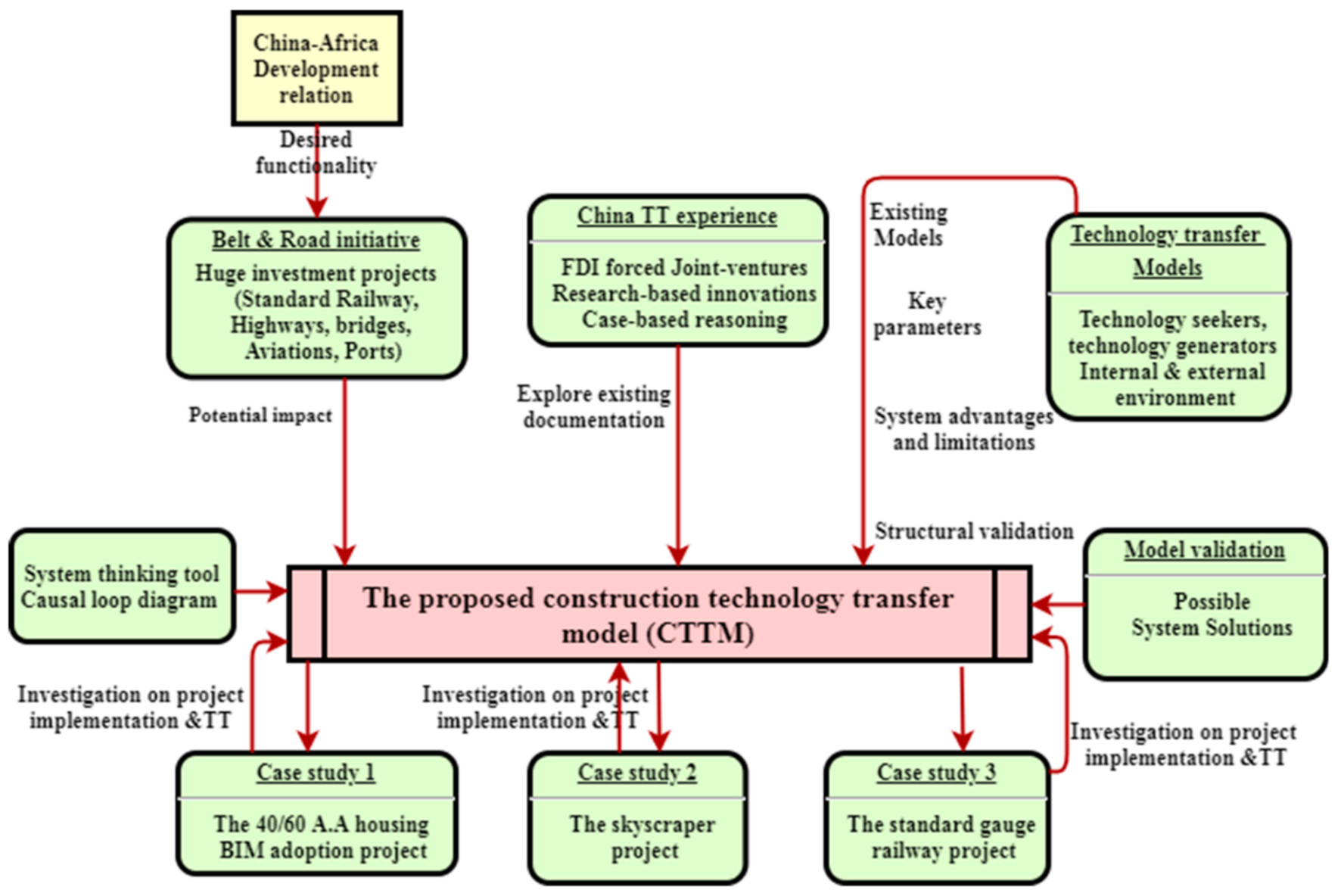
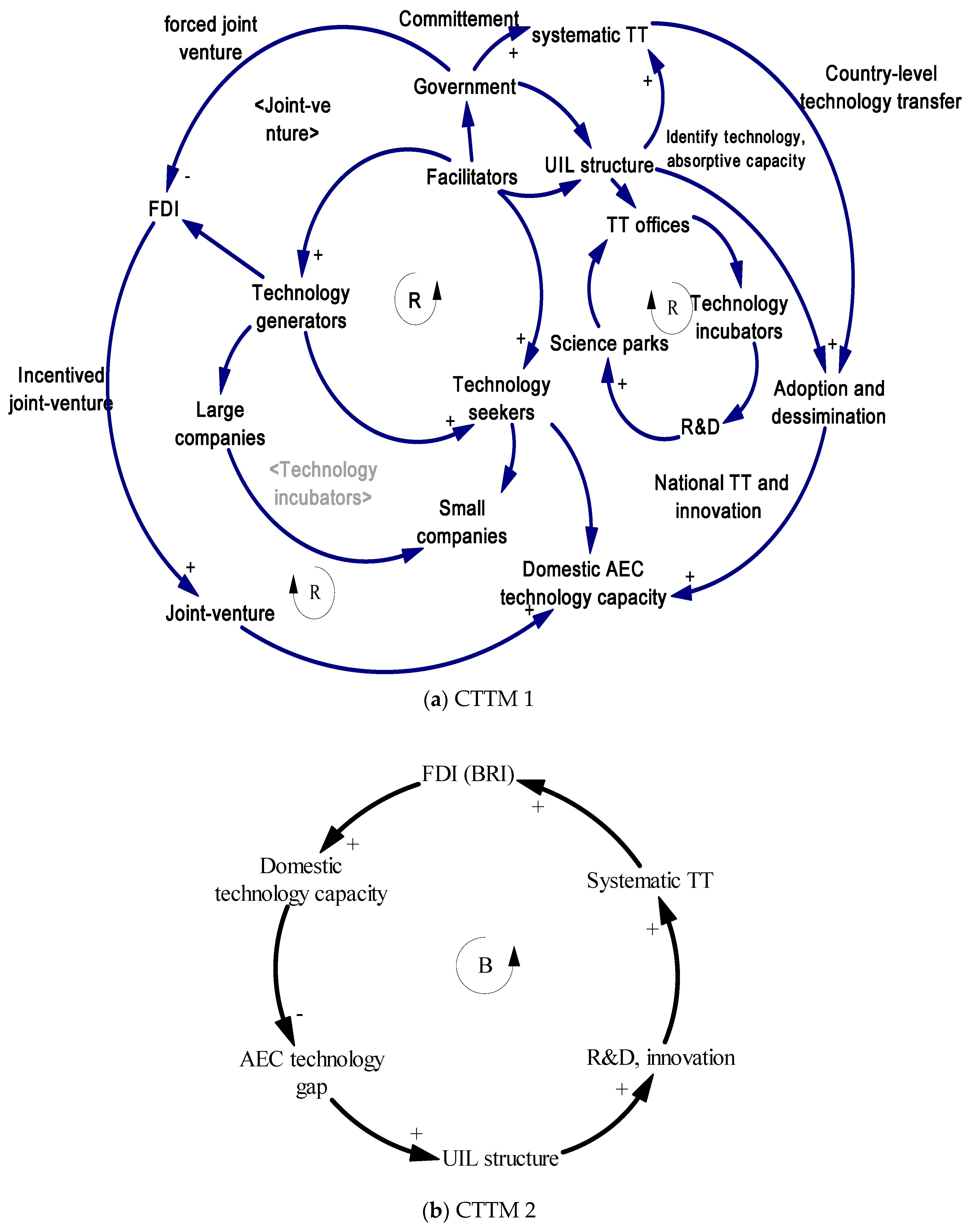

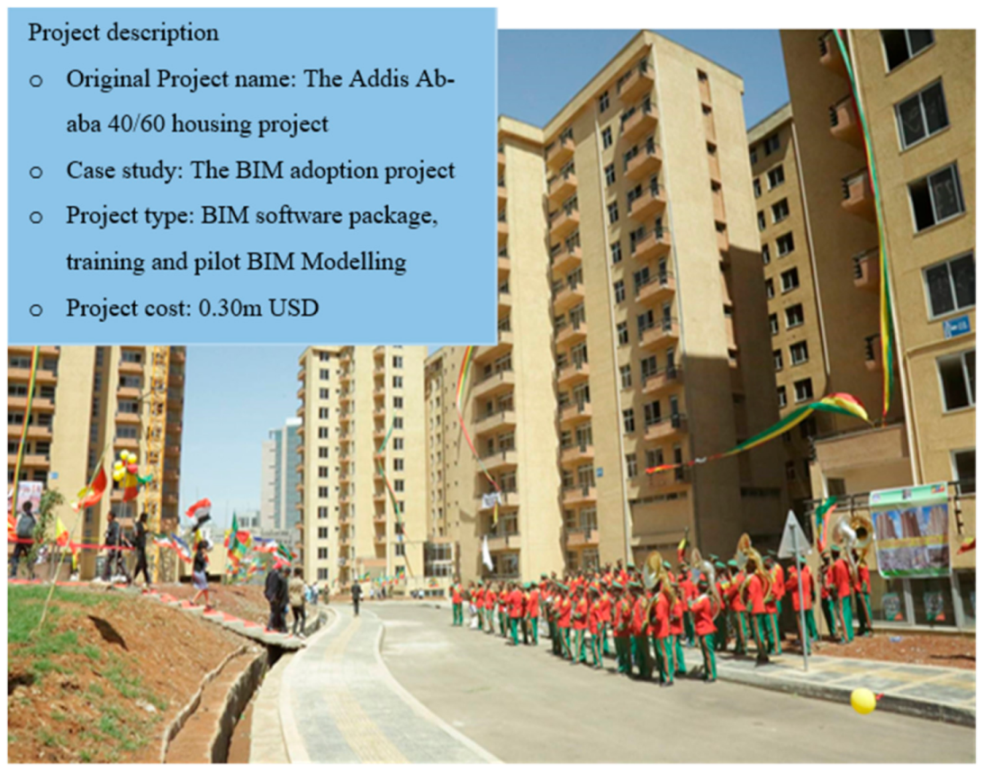

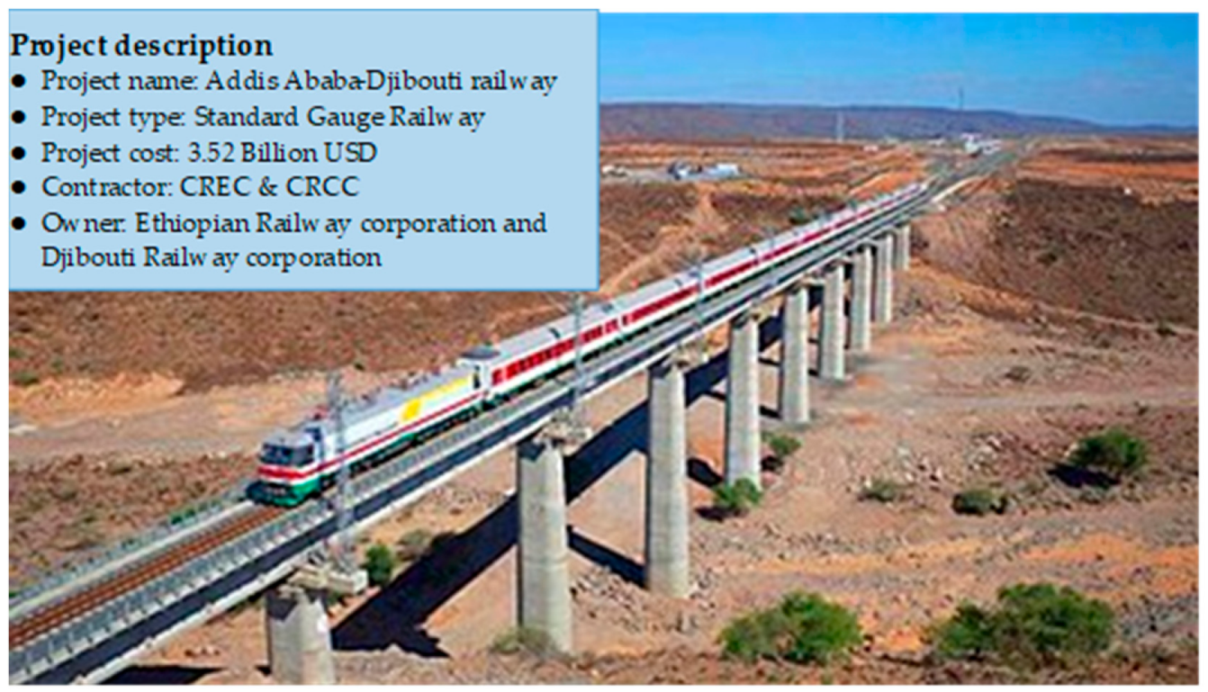
| Country | Year MOU 1 | Project Category | Project Name | Investment Amount | Chinese Contractor | Project Status |
|---|---|---|---|---|---|---|
| Djibouti | 2015 | Port | Doraleh multi-purpose port | US $599 m | China Civil Engineering Construction Corporation (CCECC) | Operating |
| 2011 | Standard Gauge Railway | Addis Ababa-Djibouti Railway | US $4 bn | China Civil Engineering Construction Corporation (CCECC) China Railway Engineering Corporation (CREC) | Operating | |
| Ethiopia | 2015 | Light Railway | Addis Ababa Light Rail | US $475 m | China Railway Group Limited Shenzhen Metro Group | Operating |
| 2007 | Industrial zone | Ethiopia’s Eastern industrial zone | US $900 m | Jiangsu Yongyuan Investment Co Ltd. | Operating | |
| Egypt | 2015 | Industrial zone | Suez canal economic zone | US $1 bn | China’s TEDA and other Chinese companies | Operating |
| 2015 | Administrative Buildings | New Administrative Capital | NA | China State Construction Engineering Corporation (CSCEC) | Under construction | |
| Kenya | 2014 | Standard Gauge Railway | Mombasa-Nairobi Standard Gauge | US $3.6 bn | China Road and Bridge corporation | Operating |
| Nigeria | 2011 | Standard Gauge Railway | Abuja–Kaduna railway line | US $876 m | China Civil and Engineering Construction Company (CCECC) | Operating |
| 2016 | Railway construction | Lagos–Calabar railway line | US $13 bln | China Railway Construction (CRC) | Under construction (2021) | |
| 2018 | Standard gauge Railway | Lagos–Kano Standard Gauge Railway | US $6.68 bln | China Civil and Engineering Construction Company (CCECC) | Under construction (2021) | |
| Uganda | 2013 | Energy | Karuma Hydropower project | US $1.7 bn | Sinohydro Corporation Limited (EPC) Shandong Taikai Transformer | Under Completion |
| Zimbabwe | 2018 | Transport | Harare Airport expansion | US $153 m | Jiangsu International | Under construction |
| No | Basic Variables | The Link Cause/Effect | Signs on the Link | Signs of the Loop |
|---|---|---|---|---|
| CTTM 1 | ||||
| 1. | Technology seeker | cause | +ve | Reinforcing (R) |
| 2. | Government/facilitator | Intermediate link | +ve | |
| 3. | Technology generator | cause | +ve | |
| 4. | FDI | cause | +ve | Reinforcing (R) |
| 5. | Joint-venture | Intermediate link | +ve | |
| 6. | Domestic technology capacity | effect | +ve | |
| 7. | Systematic TT | Cause | +ve | Reinforcing (R) |
| 8. | UIL structure | Intermediate link | +ve | |
| 9. | R&D | Intermediate link | +ve | |
| 10. | Technology incubators | Intermediate link | +ve | |
| 11. | Science parks | Intermediate link | +ve | |
| 12. | Technology adoption and dissemination | effect | +ve | |
| CTTM 2 | ||||
| 1. | Domestic technology capacity | Cause | +ve | Balancing (B) |
| 2. | Systematic TT | Cause | +ve | |
| 3. | R&D, innovation | Intermediate link | +ve | |
| 4. | UIL structure | Intermediate link | +ve | |
| 5. | FDI (BRI) | Cause | +ve | |
| 6. | AEC technology gap | effect | -ve | |
| CTTM 3 | ||||
| 1. | Domestic technology capacity | cause | +ve | Balancing (B) |
| 2. | Systematic TT | Intermediate link | +ve | |
| 3. | Forced Joint-venture | effect | -ve | |
| No | Validation Criteria | Assessment |
|---|---|---|
| 1. | Clarity | The model communicates the implied causality (clear connection, understanding) |
| 2. | Quantity existence | The variables can be quantified, and units can be defined (number of BRI projects, number of technologies adopted, number of joint-venture contracts) |
| 3. | Causality existence | There exists a causal link between parameters (FDI, joint-venture, systematic TT, domestic technology capacity) |
| 4. | Cause sufficiency | The causal linkages can create the effect expected (increase in forced joint-venture uplifts the systematic TT, which in turn enhances the domestic technology capacity, CTTM 3) |
| 5. | Additional cause possibility | The same result may be obtained from other variables independently |
| 6. | Cause/effect reversal | It is possible the reversal scenario in which both variables are both cause and effect, but in this model, the reversal effect is not feasible |
| 7. | Predicted effect existence | The predicted effect is domestic technology capacity uplift through FDI (BRI) |
| 8. | Tautology | The causal loop diagrams are logical in terms of cause and effect reasoning |
| No | Model Type | Project/Program Based | Concept | Limitations | System |
|---|---|---|---|---|---|
| 1. | Preceding models | Not typical | Theoretical | Many limitations due to the generality | Outdated for the new BRI |
| 2. | The new model | Yes (BRI) | Theoretical and practical | Few limitations, tailor-made | New system thinking model |
Publisher’s Note: MDPI stays neutral with regard to jurisdictional claims in published maps and institutional affiliations. |
© 2021 by the authors. Licensee MDPI, Basel, Switzerland. This article is an open access article distributed under the terms and conditions of the Creative Commons Attribution (CC BY) license (http://creativecommons.org/licenses/by/4.0/).
Share and Cite
Shukra, Z.A.; Zhou, Y.; Wang, L. An Adaptable Conceptual Model for Construction Technology Transfer: The BRI in Africa, the Case of Ethiopia. Sustainability 2021, 13, 3376. https://doi.org/10.3390/su13063376
Shukra ZA, Zhou Y, Wang L. An Adaptable Conceptual Model for Construction Technology Transfer: The BRI in Africa, the Case of Ethiopia. Sustainability. 2021; 13(6):3376. https://doi.org/10.3390/su13063376
Chicago/Turabian StyleShukra, Zahra Abdulhadi, Ying Zhou, and Lingling Wang. 2021. "An Adaptable Conceptual Model for Construction Technology Transfer: The BRI in Africa, the Case of Ethiopia" Sustainability 13, no. 6: 3376. https://doi.org/10.3390/su13063376
APA StyleShukra, Z. A., Zhou, Y., & Wang, L. (2021). An Adaptable Conceptual Model for Construction Technology Transfer: The BRI in Africa, the Case of Ethiopia. Sustainability, 13(6), 3376. https://doi.org/10.3390/su13063376







